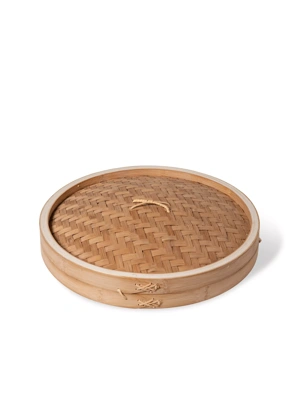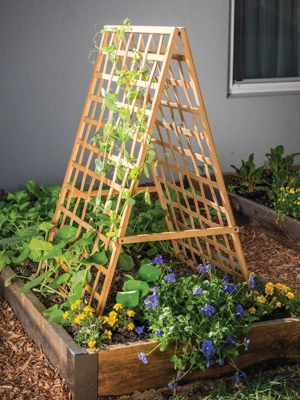Build it: Bamboo Japanese Garden Structures
 Yarai Style Bamboo Fence
Yarai Style Bamboo FenceWelcome to the world of bamboo! This fast-growing, renewable building material offers unparalleled strength and a graceful form, not only for supporting plants but also for creating decorative structures.
Below you'll find directions for constructing several traditional Japanese garden structures. These designs typically use three or four different sizes of bamboo. Very few tools are required, and with a little practice in knot-tying, you will be able to customize fence and trellis designs to suit your own garden.
 The Ibo knot
The Ibo knotThe Ibo Knot
This knot is a variation on a standard looped square knot. While any tight knot will hold most bamboo joints, this style of knot gives a neat, finished appearance and is the standard in most Japanese construction.
In most cases, hemp twine or waxed lashing cord will make snug, weather-tight joints.
Significant joints may need to be reinforced with slender nails or wrapped with fine wire.
Yarai-Style Fence
This low fence design is popular in the Kansei region of Japan, where it is often used as a property border fence. Sometimes, this type of fence is mounted on an existing stone wall.
This typically 3-foot-high fence panel that can be easily varied in height, length or in the number of canes used.
To Build:
- Use a spade or post-hole digger to dig holes at least one foot deep. Use a level and a taut string to ensure that posts are straight and the same height. Backfill post holes and tamp down.
- Each crosspiece of this fence is attached to the back of the posts using a pilot hole and nail. Measure ½ inch from each end of the cut crosspieces and drill holes straight through the cane. Nail one end in place and, using a level to ensure correct placement, nail the other end into the other post.
- Now choose the straightest possible canes for the center of your trellis pattern. Measure and mark the two canes which will form the center X carefully and cut them diagonally to lie flush against the inside edge of each fencepost as shown. Drill a pilot hole perpendicular to the post ½ inch from the end of each diagonal and nail the top and bottom to the inside of each fencepost.
- Measure, cut and add trellis pieces as shown in the illustration. Trim the upper end of each diagonal at the nearest joint. Use a taut, level string tied between each post to help align the top ends of the diagonals.
- Tie the bamboo together where the diagonals cross the back crosspiece. Tying three sections of cane together tautly can be difficult, so use wire twisted tightly with a pair of pliers for extra strength. Try loosely attaching all of the bamboo with wire. Then, check the measurements and angle and adjust, if necessary, before tightening the wire. Now trim the wire, and cover it with Black Lashing Cord, using the traditional knots.
 Yotusme-style bamboo fence near a water garden
Yotusme-style bamboo fence near a water gardenYotsume-Style Fence
This basic fence design is the most popular form in Japanese landscape architecture and has been used since ancient times. Its simple, open lines blend well with any landscape.
The fence shown here is constructed for maximum durability using naturally rot-resistant wood posts (such as cedar) into which bamboo crosspieces are inserted and vertical canes are then tied on.
To Build:
- Use a spade or post-hole digger to dig holes at least one foot deep. In the illustration the posts are 3 feet tall above the ground and 4 feet apart. Use a taut string and level between the tops of each post to ensure that they are of the same height. Fill in the post holes and tamp down well.
- Mark the inside of each post at points 1 and 2 feet down from the top of the post. Choose the straightest 1½" dia. canes (No. 8 Bamboo) to use as crosspieces and cut them to the inside dimension of your fence panel plus one inch to allow them to be inserted ½" into each of the posts. Determine the position of each crosspiece and drill a hole in each post at least ½" deep.
- Insert the crosspieces into each post and rotate each one if necessary so it looks as straight as possible. Drill a pilot hole at an angle on the back side of each crosspiece about ½ inch from the fencepost, and nail each crosspiece to the post (see illustration). Use a drill bit slightly larger than the nail and make sure the nail is long enough to go into the post. Be careful not to strike the bamboo with the nail because it may crack.
- Now that the crosspieces are in place, simply tie on the vertical canes, using ¾" dia. bamboo (No. 4 or No. 6). To get a uniform height, use a taut, level string between the posts to line up the vertical canes. Trim the canes facing upwards to the nearest joint end.
- A vertical cane can be added to each post end, but is not structurally necessary. Tie a knot around the post and crosspiece as shown for a more finished appearance.
Yotsume design variations
- Tie vertical canes all on one side or alternating front and back of the crosspieces.
- Build a taller, stockade-type fence using this design.
- Pair ¾" dia. vertical canes to create a more elegant appearance.
- Tie the crosspieces to 1½" dia. bamboo posts instead of hardwood posts. Such posts should last two or three years.
Trellises and Arbors
The same techniques used in fence construction apply to the design and construction of trellis pieces to support climbing plants. For longer-lasting trellises, minimize contact between the soil and bamboo, and store them in a protected location during the winter.
This trellis design uses three widths of bamboo in a door-style frame. The three long vertical posts are 1½" dia. canes, interior verticals and upper horizontal pieces are ¾" dia. canes and the panel at the bottom is made with pairs of thinner 3' canes (No. 2 Bamboo).
To Build:
- Lay the vertical pieces on the ground. Use a level to ensure the trellis is flat as you assemble it on the ground.
- Attach the upper three bamboo crosspieces to the three uprights. In the illustration, the outside dimension from post to post measures 2'8" across. Allow the top crosspiece, tied just below the top of each vertical post, to extend 6 inches on either side, while the two lower crosspieces should extend just 2 inches on either side.
- Now add pairs of 3-foot bamboo to the lower 2 feet of the trellis. Since the width of these canes varies, dimensions are approximate. Our illustration has eight pairs of canes spaced 3 inches apart. The spacing and dimensions of this design may be altered to suit your taste, and your patience for tying knots!
- Attach the remaining interior vertical canes equidistant from the upper crosspiece and the top pair of 3-foot canes below.
- The trellis can now be attached to an existing structure, or it can be mounted on anchor posts driven into the ground. If you choose anchor posts, the interior membranes of the canes may be punched out with a hammer and screwdriver to allow the canes to be slipped over metal anchor posts.
For a lighter, taller trellis, use 7-foot canes. Create a paravent, or fan-like screen, by placing two freestanding trellises together at an angle. Or string together several smaller panels as an informal fence.
Trim all edges close to the outside posts. This design can be mounted on hardwood posts for use as a gate or door.
 Bamboo poles and stakes are great for creating many types of plant supports.
Bamboo poles and stakes are great for creating many types of plant supports.Additional Support for Climbers and Twiners
Bamboo towers, teepees or tripods can be used to create everything from tomato trellises to arbors for annual climbing vines. Here are some ideas:
Make a tower: Form a circle of three to six bamboo poles in the garden, and tilt the ends into the center. Wrap the ends with strong twine to secure the ends together. Then, attach twine to create a web for climbing plants.
Connect towers: Positioning a horizontal bamboo pole between them at the top and bottom. Attach twine to these horizontals to create a web for climbing plants.
 jute twine strung vertically from a bamboo structure makes a great pea trellis.
jute twine strung vertically from a bamboo structure makes a great pea trellis.Custom Fencing

Split-Bamboo Fencing incorporated into horizontal fence boards.
Adrianne Caldwell of Oviedo, FL, posted this shot with a review of our split bamboo fencing. She says, "My family and I used to live in Japan, and I'm sure I saw something like it there. We now live on a small horse farm where 99 percent of the property is dedicated to the horses, but I have been able to secure the other 1 percent for me to try and recreate my love for everything Japanese. My husband and his friend are the carpenters; I'm just the idea woman. Although I got some strange looks when I dreamed up the entryway, it only took an afternoon for them to build it."
Construction Tips
- Never nail directly into bamboo. Use a drill to create pilot holes slightly smaller than the nail and a nail set to avoid crushing the cane with your hammer.
- Use a bamboo saw or a fine hacksaw for cutting.
- Always wear gloves (except when tying!) to avoid splinters.
- Bamboo will rot after two or three years of continuous contact with the soil. Therefore, use hardwood posts for ground-contact supports.
- Apply natural preservatives, such as hemp oil or tung oil to bamboo. Petroleum-based preservatives may also be used.
- Expect bamboo to turn a light, weathered gray as it ages. Canes will crack through expansion and contraction but that will not diminish their strength.
- Cut the top of any cane to be used vertically or diagonally above the nearest joint. The interior membrane at the joint will help keep water from collecting in the hollow cane.
- For the fenceposts, use rot-resistant wood, such as cedar or pressure-treated lumber, that is no bigger than 4 x 4 inches. Round fenceposts seem to blend more harmoniously than square ones.
- Apply a dark wood stain if you want to simulate the scorched appearance of traditional Japanese designs.
- It is traditional to use dark twine, known as shuro nawa, to hold the smaller bamboo pieces together. You can approximate this look with our Black Lashing Cord;.
- Bamboo canes vary in color, straightness, cracking and position of joints. Take this into account when laying out your design.
Last updated: 03/08/2024
Print this Article:
Related items
Get the Dirt
Stay up to date on new articles and advice. Please fill out the information below.











